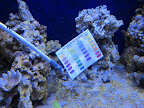I have received a couple of side questions like this:
What is your opinion on recommended wattage per gallon / number of LEDs?
Obviously a key question, and naturally, very hard to answer.
If you want a really quick, safe, and expensive answer, the common rule is
to go with about 3W per gallon, with dimmers. You will see that on RC and other places.
I am running 1.8 W / gallon, and it seems slightly too bright.
---
So what do you need? It depends:
1) Actual "wattage".
It is important to use your actual power, not the LED rating.
For example, we often use 3W Cree LEDs.
But we usually run them at 700 mA.
And you need to look at the forward voltage at that specific current.
So real wattage for that example = 0.7 A * 3.4 = 2.38W
2) Coral requirements.
Very basic - what types of coral do you plan, and what PAR do they need.
3) How do you get the light to the coral.
A very complex topic in itself.
This is a function of coral (not tank) depth, fixture height, optics, acrylic shield.
This can make a huge difference. Factor of 2, easy.
So a lot of thought needs to go into that.
4) Type of LEDs and how you run them.
There is a big difference in lumens/watt between different LEDs. (XP-G / XP-E / Luxeon / etc)
Plus, there is a big difference depending on the current. You get a more lumes/W at 350 mA than 1500 mA.
Temperature matters a lot as well, but I assume these will be run cold.
What also matters is the wavelengths used. But since most build will be predominantly RB + CW, that can
pretty much be ignored.
5) How long you plan to run the lights.
Assuming you are in the correct PAR ballpark, a lot of tweaking can be done
by simply changing the time the lights are on.
---
So, like a lot of things, no perfect answer, only ranges and opinions.
My opinion : Somewhere between 1 and 4. Not that helpful.
---
A secondary problem : The normal real solution for regular lighting is to measure PAR.
Unfortunately, most PAR meters, the cheap ones in particular, do not handle LEDs well, so
the measurement is unreliable.





